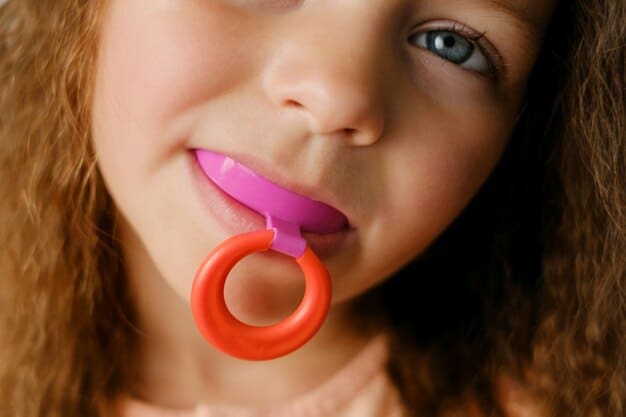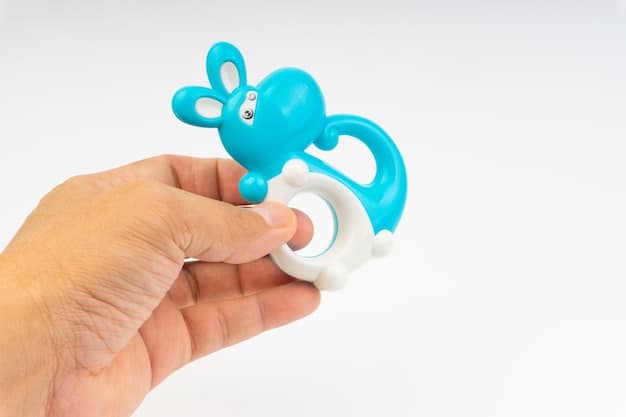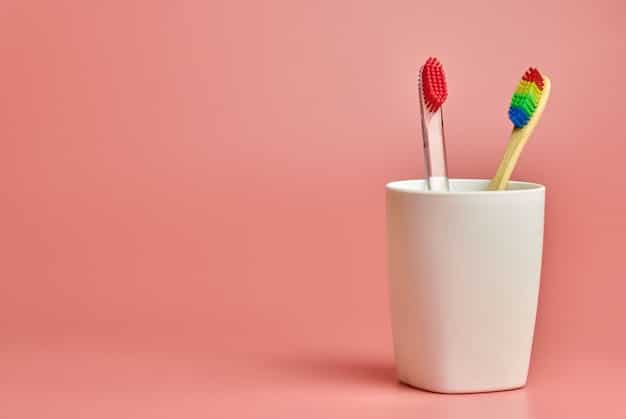Teething Troubles Solved: 5 Doctor-Approved Remedies

Teething troubles are a common source of discomfort for toddlers, but several doctor-recommended remedies, including chilled teethers, gentle gum massage, and appropriate pain relievers, can provide significant relief.
Is your toddler constantly fussing, drooling, and chewing on everything in sight? You’re likely dealing with **teething troubles**, a challenging but normal phase in your child’s development.
Understanding Teething and Its Symptoms
Teething is the process where a baby’s first teeth erupt through the gums. It’s a significant milestone, but it can bring discomfort to your little one.
When Does Teething Usually Start?
The timing of teething varies, but it typically begins around 6 months of age. Some babies may start earlier, while others may be a bit later.
Understanding the typical timeline can help you anticipate and prepare for the associated symptoms.
Common Signs That Your Baby Is Teething
Recognizing the signs of teething can help you provide timely relief for your baby. Look out for these key indicators:
- Increased drooling: Excessive saliva production is a common sign.
- Gum swelling and redness: The gums may appear inflamed in the area where the tooth is erupting.
- Irritability and fussiness: Teething can cause discomfort, leading to increased crying and restlessness.
- Chewing on objects: Babies often try to relieve gum pressure by chewing on anything they can get their hands on.
Teething is a natural part of development, but managing the symptoms effectively can ease discomfort.
Doctor-Recommended Remedy 1: Chilled Teething Toys
One of the simplest and most effective remedies for teething pain is providing your toddler with chilled teething toys. The coldness helps to numb the gums, providing temporary relief.

Choosing the Right Teething Toy
It’s essential to select teething toys that are safe for your child. Look for options that are:
- BPA-free: Ensure the toy is made from materials that do not contain Bisphenol A (BPA), a harmful chemical.
- Easy to grip: Choose a teether with a design that is easy for your toddler to hold and manipulate.
- Made of durable material: The toy should be able to withstand repeated chewing without breaking.
- Appropriately sized: The teether should be large enough that the child cannot swallow it, preventing a choking hazard.
Selecting the right teething toy can make a big difference in your baby’s comfort and safety. Always supervise your baby while they are using a teether.
How to Chill Teething Toys Safely
When chilling teething toys, it’s important to do so safely to avoid harming your baby. Follow these guidelines:
- Use the refrigerator, not the freezer: Freezing a teether can make it too hard and potentially damage the gums.
- Clean the teether thoroughly before chilling: Ensure the teether is free of bacteria before your baby puts it in their mouth.
- Avoid chilling liquid-filled teethers: If the teether cracks, the liquid could leak out and pose a risk.
Properly chilled teething toys can be a soothing and effective solution for teething discomfort.
Using chilled teething toys is a safe and effective way to help ease your toddler’s teething pains. Always ensure the toy is clean and made of safe materials.
Doctor-Recommended Remedy 2: Gentle Gum Massage
Massaging your baby’s gums can help alleviate the pressure and discomfort associated with teething. This simple method provides a gentle way to soothe the inflamed area.
How to Perform a Gum Massage
Performing a gum massage is easy and can be done with clean fingers or a soft, damp cloth. Here’s how:
- Wash your hands thoroughly: Ensure your hands are clean before touching your baby’s mouth.
- Use a clean finger or damp cloth: Gently rub the affected gums in a circular motion.
- Apply gentle pressure: Avoid pressing too hard, as this could cause more discomfort.
- Massage for a few minutes: Repeat the massage several times a day, especially when your baby seems fussy.
Gum massage can be a comforting experience for your baby and provide temporary pain relief. Pay attention to your baby’s cues and adjust the pressure accordingly.
Benefits of Gum Massage
The benefits of gum massage extend beyond just pain relief. Regular massage can:
- Reduce gum inflammation: The gentle pressure can help decrease swelling.
- Improve blood circulation: Increased blood flow can promote healing and reduce discomfort.
- Provide comfort: The act of massaging can be soothing and help calm your baby.
Incorporating gum massage into your teething routine can be a great way to bond with your baby while providing relief.
Gentle gum massage is a natural and effective way to ease teething pain. It’s a comforting practice that can help reduce inflammation and improve circulation.
Doctor-Recommended Remedy 3: Over-the-Counter Pain Relievers
When other remedies aren’t providing enough relief, over-the-counter (OTC) pain relievers can be a helpful option. It is crucial to consult with your pediatrician before administering any medication.
Safe Use of Pain Relievers
Acetaminophen (such as Tylenol) and ibuprofen (such as Motrin) are commonly recommended for teething pain. However, it’s essential to:
- Consult with your pediatrician: Always speak to your doctor before giving any medication to your child.
- Follow dosage instructions carefully: Adhere strictly to the recommended dosage based on your child’s weight and age.
- Avoid using for extended periods: Do not use pain relievers for more than a few days without consulting your doctor.
- Never use aspirin: Aspirin is not safe for infants and children due to the risk of Reye’s syndrome.
Using pain relievers responsibly can help manage severe teething pain, but always prioritize safety and consult a healthcare professional.
Alternatives to Pain Relievers
Before resorting to pain relievers, consider exploring other alternatives to manage teething discomfort:
- Teething biscuits: These can provide something to chew on and help massage the gums.
- Cold foods: If your baby is eating solids, chilled fruits or vegetables can offer relief.
- Distraction: Engaging your baby in play or activities can help take their mind off the pain.
Exploring alternative remedies can reduce the need for medication and provide a well-rounded approach to managing teething pain.
While OTC pain relievers can be effective, they should be used judiciously and under the guidance of a pediatrician. Prioritize non-medicinal remedies whenever possible.
Doctor-Recommended Remedy 4: Gum-Numbing Gels
Gum-numbing gels are designed to provide temporary relief from teething pain. However, it’s crucial to be aware of the potential risks and use them sparingly.

Risks Associated with Gum-Numbing Gels
The FDA has issued warnings about benzocaine-containing products due to the risk of methemoglobinemia, a rare but serious condition that reduces the amount of oxygen in the blood. Keep in mind:
- Methemoglobinemia: Benzocaine, a common ingredient in gum-numbing gels, can cause this condition.
- FDA warnings: The FDA advises against using benzocaine products for teething.
Given the potential risks, it’s crucial to explore safer alternatives for managing teething pain.
Safer Alternatives to Gum-Numbing Gels
Instead of using gum-numbing gels, consider these safer and equally effective options:
- Chilled teething toys: Provide a safe and soothing alternative.
- Gentle gum massage: Offers natural pain relief without the risk of side effects.
- Acetaminophen or ibuprofen: Use these medications under the guidance of a pediatrician.
By choosing safer alternatives, you can protect your baby from potential harm while providing effective relief.
Due to potential risks and FDA warnings, gum-numbing gels should be avoided for teething pain. Opt for safer alternatives like chilled teethers and gentle gum massage.
Doctor-Recommended Remedy 5: Teething Biscuits and Food
Teething biscuits and appropriate solid foods can provide relief as your baby chews, applying gentle pressure to the gums. It is crucial to introduce these items safely and age-appropriately.
Choosing the Right Teething Biscuits or Food
When selecting teething biscuits or foods, consider the following:
- Age-appropriateness: Choose biscuits or foods suitable for your baby’s developmental stage.
- Ingredients: Opt for products with natural and healthy ingredients, avoiding added sugars, salts, and preservatives.
- Texture: Ensure that the texture is soft enough to prevent choking.
- Allergies: Check the ingredients list carefully to avoid potential allergens.
Selecting the right teething biscuits or foods can provide relief and introduce new flavors and textures to your baby.
Safety Precautions When Using Teething Biscuits or Food
To ensure safety when using teething biscuits or offering food for teething, follow these precautions:
- Supervision: Always supervise your baby while they are eating or chewing on teething biscuits.
- Size: Avoid large pieces that could pose a choking hazard.
- Hydration: Offer water to help soften the biscuits and prevent choking.
- Introduction: Introduce new foods one at a time to monitor for allergic reactions.
By following these safety precautions, you can safely incorporate teething biscuits and foods into your baby’s routine.
Teething biscuits and appropriate solid foods can be a safe and effective way to provide relief. Always supervise your baby and choose products with healthy ingredients.
| Key Point | Brief Description |
|---|---|
| 🥶 Chilled Teethers | Numb gums with safe, refrigerated teethers. |
| 🖐️ Gum Massage | Gentle massage can alleviate gum pressure and inflammation. |
| 💊 OTC Pain Relief | Use acetaminophen or ibuprofen as directed by pediatrician. |
| 🍪 Teething Biscuits | Provide safe chewing relief; supervise closely. |
Frequently Asked Questions
▼
Most babies start teething around 6 months of age, but it can vary. Some may start as early as 3 months, while others might not get their first tooth until after their first birthday.
▼
Common signs include increased drooling, gum swelling, irritability, and the urge to chew on things. A low-grade fever and changes in sleep patterns may also indicate teething.
▼
Avoid giving your baby sugary or acidic foods, as these can harm their developing teeth. Hard or crunchy foods that could pose a choking hazard should also be avoided during this time.
▼
Teething itself does not typically cause diarrhea or a high fever. If your baby experiences these symptoms, it’s best to consult with a doctor to rule out other potential causes.
▼
Clean your baby’s gums with a soft, damp cloth or a baby toothbrush at least twice a day, especially after feedings and before bedtime, to establish good oral hygiene habits.
Conclusion
Dealing with **teething troubles** can be challenging, but by using these doctor-recommended remedies and providing plenty of comfort and care, you can help your little one get through this phase with minimal discomfort. Remember to always consult with your pediatrician for personalized advice and to address any concerns you may have.





